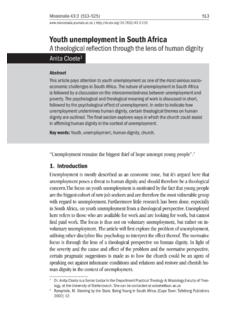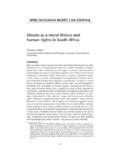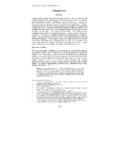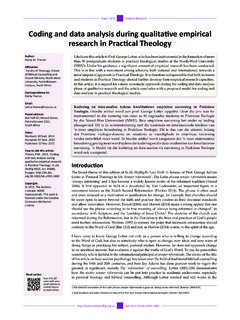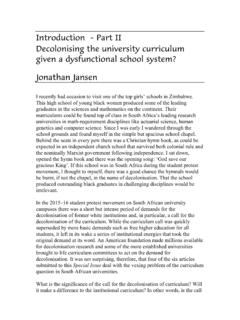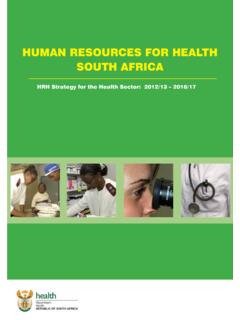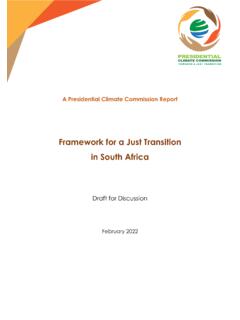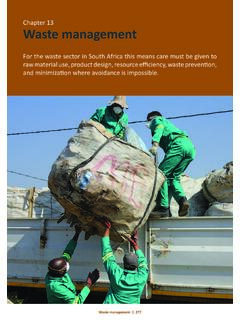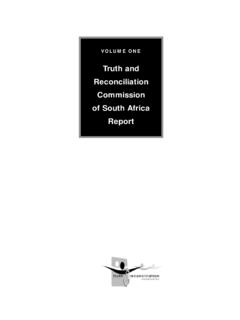Transcription of Extreme apartheid: the South African system of migrant …
1 Extreme apartheid: the South African system of migrant labour and its hostels > Christo Vosloo University of Johannesburg, Johannesburg, South africa (ORCID: ). ABSTRACT. The migrant labour system was an historical system used to reconcile the conflicting need for cheap labour in the mines and cities, with the apartheid ideology that workers should not reside there on a permanent basis. Labourers were housed in a unique accommodation type that developed from the Kimberley Closed Compound into the Witwatersrand Mine Compound and ultimately the migrant labour hostel. During the late colonial and apartheid periods, the mining compounds and the migrant labour hostels, which formed a key element of this system , were designed (and functioned) as tools of control and repression. In time they became synonymous with violence, overcrowding and squalor.
2 As with so many other political and social systems, dismantling the migrant labour apparatus, and undoing the harm it caused, often requires even more tenacious efforts over a period of time. Keywords: Migrancy; compounds; hostels; workers' housing; control; apartheid. Published by Original research Number 34, 2020 ISSN 2617-3255 page 01 of 33. DOI: Creative Commons Attribution International (CC BY ). Introduction The migrant labour system was an historical system , manipulated by capitalist, colonial and apartheid powers as a means of reconciling the conflicting needs for cheap labour in the mines and cities of white South africa , with the desire to restrict black people to rural areas far away from the white cities. As part of this system , people (mostly men) were forced to migrate to places of employment but were not permitted to do so with their families or stay permanently, resulting in a system of oscillating migrancy (Posel in Bank 2017:6).
3 The hostels that formed a key element of this system were, and remain to this day, physical legacies of the systematic policy of racial discrimination and blatant economic exploitation of the indigenous people of South africa (Hunter & Bundy in Ramphele 1993:15). This article briefly reflects on the South African migrant labour system in its historical context. By way of a literature study, the article provides a concise overview of the origin, history and current form of the migrant labour system . Furthermore, the forms of the three historical building typologies developed during the three distinct manifestations of this system are considered, namely the Kimberley Closed Compound, the Witwatersrand Mine Compound and the migrant labour hostel. This is because authors, such as Fassil Demissie (1998:445), have highlighted that current research largely ignores the aspects of architecture and spatial organisation that formed a critical part in the operation of the apartheid system .
4 The forementioned aspects rely on information and images obtained from various museums in Kimberley and Johannesburg. The aim is to show that the migrant Labour Hostels is one example where the legacy of apartheid planning and thinking continue to frustrate the ideals of social and physical transformation of our cities and society as a whole. Design and spatial control In 1785, the English philosopher and social theorist, Jeremy Bentham, proposed the idea of the panopticon a design for a jail and a social control mechanism that became a symbol of authority and discipline (Butchart 1996:187). The principle behind the panopticon's design is the ability to survey the maximum number of prisoners with as few guards as possible. The layout comprises a central tower housing the guards; surrounding it is a ring-shaped building comprising a single layer of wedge- shaped prison cells (Joukowsky Institute for Archaeology & the Ancient World 2009:[sp]).
5 The cells have one open side facing the guards. This allows the guards to see the entire cell at any time, leaving the prisoners vulnerable and visible, while prisoners cannot see into the central tower. Number 34, 2020 ISSN 2617-3255 page 02 of 33. During the 1970s, the French philosopher, Michel Foucault, identified four design strategies through which authorities can achieve power in institutions such as prisons, asylums, schools and so forth. An important aspect of his theory is the link between visibility and power. The first of these design strategies revolves around the need to create observatories through the building's layout and spatial configuration. Spaces are designed and buildings arranged in such a way that it allows the observation of the inhabitants in order to get to know them, and through the awareness of being observed, ultimately alter their behaviour through self-policing.
6 By arranging spaces in this way, the physical environment becomes a relay system that allows power to be exercised on the inmates by the authorities (Foucault 1977:78). In time, this power is internalised and the inmates exercise control over themselves without the need for external surveillance, thereby locking individuals into a permanent continuum of power and control (Foucault 1977:78). Panoptical layouts are the most obvious regime to accomplish this objective (Foucault 1977:195). However, disciplinary power can also be exercised by normalising judgement. The inhabitants are subjected to micro penalties and restrictions in the form of time, activity, behaviour, speech, the body and sexuality modifications, thus creating strict confines and understandings of what is acceptable and what is not (Foucault 1977:78).
7 Strict routines coupled with punishment and incarceration are the means by which this aim can be achieved. The imposition of a disciplinary regime and a strict programme governing the sequence in which things are done is required; even the behaviour and sequence of bodily movements must be regulated (Foucault 1977:73-104). Finally, disciplinary power is created through examination a combination of both hierarchical observation and normalising of judgement. In each of the variants of the migrant labour hostels that are reviewed in this article, these techniques were exercised as ways of controlling the workforce through power relations. The South African system of migrant labour: a brief historic overview Over a period of approximately 500 years, before the arrival of colonialists, a trade network developed across Southern africa (Delius, Philips & Rankin-Smith in Delius 2017:1).
8 A characteristic of this network was that men from the area, currently known as South africa , had for centuries sought income and employment in places away from their homes by moving to other areas that formed part of this network (Delius 2017:2). Peter Delius holds that from about 1850, the growth of new economic centres and a demand for labour, caused by the rise of the commercial production of wool and the growing sugar cane industry in what is now KwaZulu-Natal, led to the first Number 34, 2020 ISSN 2617-3255 page 03 of 33. changes to this system . These changes eventually resulted in what became known as the migrant labour system , wherein colonial and postcolonial politicians and capitalists abducted the system to suit their own ends. Much has been written about the migrant labour system since 1970, when Giovani Aright (in Delius 2017:11) postulated that it was the mingling of market forces and underdeveloped tribal economies that drew men into migrant labour.
9 Delius (2017:12). contends that this argument became the backdrop for the debate that followed between the voluntarists' and the revisionists'. Whereas the voluntarists ascribed the phenomenon of migrancy in South africa to market forces operating in the context of backward local economies in tribal areas, the revisionists stressed the critical role of conquest, dispossession of land, increasing taxes aided by draconian pass laws, centralised recruiting, compounds, and divide and rule tactics, in grappling for an understanding of the causes for the expansion of this system (Delius 2017:11-12). The debate was followed by a second wave of revisionists', including Harold Wolpe and Colin Bundy (in Ramaphele 1993:15), who argued that the need for cheap labour, as described previously, was the seed that spawned the systems of segregation and apartheid.
10 This view is supported by many, including Francis Wilson (1972). Another theme that emerges from various writers is the need to control the movement and behaviour of migrant workers, in other words, the need to have a constant labour force, as well as to put a stop to illegal diamond trading and disorderly behaviour (Turrell 1987 & Van der Horst 1971 in Wentzel 1993:1-3). Control was uppermost in the minds of the segregationists within government, who sought to manage the influx of much needed black labour into white areas. The migrant labour system evolved and flourished during a period that stretched over approximately 125 years, that is to say, from 1860 until 1985 (Wilson 1972:62; Cooke 1996:l).2 However, remnants of the system persist at various mine sites, with some of the migrant labour hostels remaining just as they existed decades ago, despite the post-1994 changes in government policy that sought to convert the sites into family housing.


